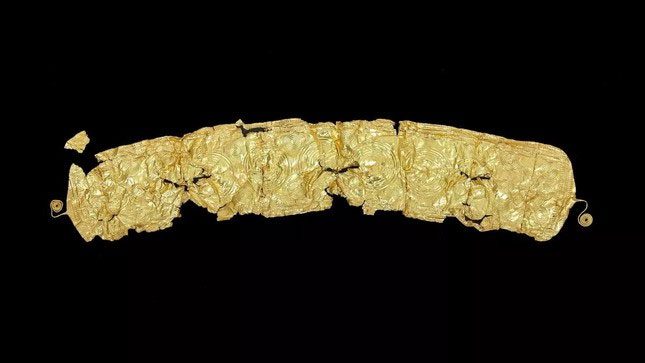Last month, a turnip farmer in the Czech Republic unearthed a thin, crumpled gold plate nearly 2,500 years old. This intricately decorated artifact, covered in dirt but well-preserved, was assessed by archaeologists at the Silesian Museum in nearby Opava.
Jiří Juchelka, head of the archaeology department at the Silesian Museum, believes that the 51 cm long object – made from a gold alloy that includes silver, copper, and iron – is likely the front of a leather belt.
Juchelka stated: “It is adorned with raised concentric circles and features a rose-shaped clasp at the end. It may be missing a few small parts, but otherwise, it is in perfect condition.”

The gold belt covered with raised concentric circles.
Conservator Tereza Alex Kilnar has begun the stabilization and analysis of this belt at the Bruntál Museum, collaborating with other experts. Based on the decorative style, she estimates that the gold belt dates from the mid to late Bronze Age, around the 14th century BC.
Central Europe during this time (2000 BC to 1200 BC) was a blend of various cultures connected by a vast trade network. It was an era of self-sufficient farmers who cultivated wheat and barley and raised domesticated livestock, as society became more complex, with a hierarchy emerging between poor farmers and the wealthy political and economic elite.
Archaeological evidence suggests that people lived in early timber-framed houses during the Bronze Age and moved to larger settlements by the middle of this period.
While the Bronze Age is known for its abundance of bronze artifacts, raw materials like gold were also traded and crafted into prestigious items for the elite. Archaeologists have found gold objects in high-status graves in Central Europe during the Bronze Age. However, gold artifacts have also been discovered in caches at special, isolated locations, suggesting a form of gift exchange between cultural elites and the supernatural.
Experts believe that this belt likely belonged to someone of high status in society, as valuable items like this were rarely produced at that time.
Catherine Frieman, an archaeologist at the Australian National University specializing in metalworking in the European Bronze Age, agreed that the owner of the gold belt was a person of high status, possibly social or spiritual.
Frieman remarked: “The Bronze Age witnessed a significant advancement in metalworking activities, including the crafting of highly decorative gold and the widespread distribution of exquisite gold objects in Central and Western Europe. Gold objects with circular motifs are often associated with Bronze Age cosmological systems believed to focus on solar cycles.”
While the decorative patterns have yet to be thoroughly studied, the significance of the gold belt is already clear. Frieman stated: “It is rare to find jewelry of this kind and in such intact fragility because thin gold can tear like paper. Discovering particularly special gold artifacts during excavations is extremely rare.”
After the belt has been studied and preserved, the Bruntál Museum plans to display it to the public.


















































